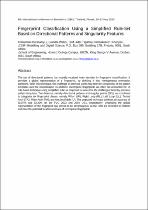 ResearchSpace
ResearchSpace
Fingerprint classification using a simplified rule-set based on directional patterns and singularity features
JavaScript is disabled for your browser. Some features of this site may not work without it.
- ResearchSpace
- →
- Research Publications/Outputs
- →
- Conference Publications
- →
- View Item
| dc.contributor.author |
Dorasamy, K

|
|
| dc.contributor.author |
Webb, L

|
|
| dc.contributor.author |
Tapamo, J

|
|
| dc.contributor.author |
Khanyile, NP

|
|
| dc.date.accessioned | 2015-10-05T07:24:00Z | |
| dc.date.available | 2015-10-05T07:24:00Z | |
| dc.date.issued | 2015-07 | |
| dc.identifier.citation | Dorasamy, K, Webb, L, Tapamo, J and Khanyile, N.P. 2015. Fingerprint classification using a simplified rule-set based on directional patterns and singularity features. | en_US |
| dc.identifier.uri | http://ieeexplore.ieee.org/xpl/articleDetails.jsp?reload=true&arnumber=7139102 | |
| dc.identifier.uri | http://hdl.handle.net/10204/8150 | |
| dc.description | 8th International conference on Biometrics (IEEE), Thailand, Phuket, 19-22 May 2015. Due to copyright restrictions, the attached PDF file only contains the abstract of the full text item. For access to the full text item, please consult the publisher's website | en_US |
| dc.description.abstract | The use of directional patterns has recently received more attention in fingerprint classification. It provides a global representation of a fingerprint, by dividing it into homogeneous orientation partitions. With this technique, the challenge in previous works has been the complexity of the pattern templates used for classification. In addition, incomplete fingerprints are often not accounted for. A rule-based technique using simplified rules is proposed to overcome the challenges faced by previous pattern templates. Two features, namely directional patterns and singular points (SPs), are combined to categorise six fingerprint classes: namely Whorl (W); Right Loop (RL); Left Loop (LL); Tented Arch (TA); Plain Arch (PA); and Unclassifiable (U). The proposed technique achieves an accuracy of 92.87% and 92.20% on the FVC 2002 and 2004 DB1, respectively. Analysing the global representation of the fingerprint has proved to be advantageous, as the rules are invariant to rotation and have the potential to address issues of incomplete fingerprints. | en_US |
| dc.language.iso | en | en_US |
| dc.publisher | IEEE Xplore | en_US |
| dc.relation.ispartofseries | Workflow;15492 | |
| dc.subject | Automated biometric-based recognition systems | en_US |
| dc.subject | Internet commerce | en_US |
| dc.subject | Fingerprint classification. | en_US |
| dc.title | Fingerprint classification using a simplified rule-set based on directional patterns and singularity features | en_US |
| dc.type | Conference Presentation | en_US |
| dc.identifier.apacitation | Dorasamy, K., Webb, L., Tapamo, J., & Khanyile, N. (2015). Fingerprint classification using a simplified rule-set based on directional patterns and singularity features. IEEE Xplore. http://hdl.handle.net/10204/8150 | en_ZA |
| dc.identifier.chicagocitation | Dorasamy, K, L Webb, J Tapamo, and NP Khanyile. "Fingerprint classification using a simplified rule-set based on directional patterns and singularity features." (2015): http://hdl.handle.net/10204/8150 | en_ZA |
| dc.identifier.vancouvercitation | Dorasamy K, Webb L, Tapamo J, Khanyile N, Fingerprint classification using a simplified rule-set based on directional patterns and singularity features; IEEE Xplore; 2015. http://hdl.handle.net/10204/8150 . | en_ZA |
| dc.identifier.ris | TY - Conference Presentation AU - Dorasamy, K AU - Webb, L AU - Tapamo, J AU - Khanyile, NP AB - The use of directional patterns has recently received more attention in fingerprint classification. It provides a global representation of a fingerprint, by dividing it into homogeneous orientation partitions. With this technique, the challenge in previous works has been the complexity of the pattern templates used for classification. In addition, incomplete fingerprints are often not accounted for. A rule-based technique using simplified rules is proposed to overcome the challenges faced by previous pattern templates. Two features, namely directional patterns and singular points (SPs), are combined to categorise six fingerprint classes: namely Whorl (W); Right Loop (RL); Left Loop (LL); Tented Arch (TA); Plain Arch (PA); and Unclassifiable (U). The proposed technique achieves an accuracy of 92.87% and 92.20% on the FVC 2002 and 2004 DB1, respectively. Analysing the global representation of the fingerprint has proved to be advantageous, as the rules are invariant to rotation and have the potential to address issues of incomplete fingerprints. DA - 2015-07 DB - ResearchSpace DP - CSIR KW - Automated biometric-based recognition systems KW - Internet commerce KW - Fingerprint classification. LK - https://researchspace.csir.co.za PY - 2015 T1 - Fingerprint classification using a simplified rule-set based on directional patterns and singularity features TI - Fingerprint classification using a simplified rule-set based on directional patterns and singularity features UR - http://hdl.handle.net/10204/8150 ER - | en_ZA |





